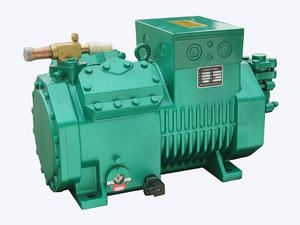Variable speed compressors are one of the most important features in semi-hermetic industrial chillers for managing varying load conditions. These compressors adjust their rotational speed based on the cooling demand from the system. When there is a lower demand for cooling (for example, when external temperatures are cooler or when the system needs less cooling), the compressor reduces its speed, which helps conserve energy by only using the necessary power. Conversely, when the load increases (such as during hot weather or when the system requires more cooling), the compressor speeds up to meet the increased demand for refrigeration. This dynamic adjustment to compressor speed allows the chiller to operate more efficiently across a wide range of load conditions and ensures that energy use is closely aligned with the actual requirements of the system, resulting in greater energy savings and reduced operational costs. Variable-speed compressors reduce wear and tear on the system, leading to extended equipment life and less frequent maintenance.
Semi-hermetic chillers are equipped with electronic expansion valves (EEVs), which are essential for precise regulation of refrigerant flow to the evaporator. These valves continuously adjust the flow of refrigerant based on the load demand and temperature fluctuations, ensuring that the system operates at optimal efficiency. By controlling the refrigerant flow more accurately than traditional mechanical expansion valves, the EEV can optimize the heat exchange process within the evaporator. During periods of fluctuating temperatures or varying load conditions, the expansion valve ensures that the correct amount of refrigerant is introduced to the evaporator, preventing undercooling or overcooling. This level of control minimizes energy consumption and ensures that the system responds quickly to both external temperature changes and internal cooling requirements.
Many semi-hermetic chillers are designed with multiple evaporators or operate through staging. This means that the chiller can engage only the necessary number of evaporators or compressors based on the cooling load. In a situation where the cooling demand is low (such as during cooler weather), only one or two compressors or evaporators may operate, while others stay inactive or run at reduced capacity. This staged operation ensures that the system does not waste energy by running unnecessary components. Conversely, when the load increases, such as during periods of high heat or increased cooling demand, additional compressors or evaporators are brought online to meet the demand. This modular approach allows the chiller to adapt dynamically to changing conditions while maintaining energy efficiency and ensuring that it can scale its performance to meet the exact needs of the system at any given time.
Modern semi-hermetic chillers are equipped with advanced control systems that use sensors to constantly monitor parameters such as temperature, pressure, flow rates, and ambient conditions. These control systems can automatically adjust key variables, such as compressor speed, refrigerant flow, and evaporator temperature, in real time to match the changing conditions. For example, the system may increase refrigerant flow when ambient temperatures rise, or it might reduce the compressor's speed when the external temperature drops. This real-time adjustment allows the chiller to maintain optimum performance and prevent energy waste, ensuring that it operates efficiently under varying external and internal conditions. The integrated control systems also offer diagnostic capabilities, allowing for predictive maintenance and reducing the risk of sudden breakdowns by identifying potential issues before they become critical.

 English
English عربى
عربى 简体中文
简体中文












